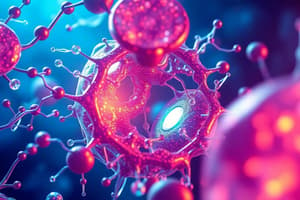Podcast
Questions and Answers
What does the cell theory state?
What does the cell theory state?
- All living organisms are composed of cells. (correct)
- All cells arise from pre-existing cells. (correct)
- Cells are the basic unit of life. (correct)
- Cells can arise spontaneously.
What is the function of the eyepiece in a microscope?
What is the function of the eyepiece in a microscope?
Magnifies the image.
What is the formula for calculating total magnification in microscopy?
What is the formula for calculating total magnification in microscopy?
Total magnification = eyepiece magnification × objective magnification.
Which type of microscope provides a 3D view?
Which type of microscope provides a 3D view?
Light microscopes can observe live cells.
Light microscopes can observe live cells.
All unicellular organisms are multicellular.
All unicellular organisms are multicellular.
Which organelle is known as the powerhouse of the cell?
Which organelle is known as the powerhouse of the cell?
Photosynthesis converts sunlight, carbon dioxide, and water into ______.
Photosynthesis converts sunlight, carbon dioxide, and water into ______.
Cellular respiration converts glucose and oxygen into ______, carbon dioxide, and water.
Cellular respiration converts glucose and oxygen into ______, carbon dioxide, and water.
What condition increases the rate of cellular respiration?
What condition increases the rate of cellular respiration?
What are stem cells used for in medicine?
What are stem cells used for in medicine?
Match the following types of cells with their functions:
Match the following types of cells with their functions:
What are the three layers of skin?
What are the three layers of skin?
Flashcards are hidden until you start studying
Study Notes
Cell Theory
- All living organisms are made of one or more cells.
- The cell is the fundamental unit of life.
- All cells originate from pre-existing cells.
Microscope Parts
- Eyepiece (Ocular Lens): Magnifies the image.
- Objective Lenses: Provide varying magnifications (e.g., low, medium, high).
- Stage: Supports the slide.
- Stage Clips: Secure the slide in place.
- Light Source: Illuminates the specimen.
- Condenser: Focuses light onto the specimen.
- Coarse Adjustment Knob: Moves the stage for rough focusing.
- Fine Adjustment Knob: Fine-tunes the focus.
Microscope Magnification
- The total magnification is calculated by multiplying the eyepiece magnification by the objective magnification.
Monocular vs. Stereo Microscopes
- Monocular Microscope:
- It has a single eyepiece.
- It provides higher magnification.
- It's used for viewing thin specimens.
- Stereo Microscope:
- It has two eyepieces.
- It provides lower magnification.
- It offers a 3D view.
- It's used for larger or opaque specimens.
Light vs. Electron Microscopes
- Light Microscope:
- Uses light to magnify specimens.
- Can be used to observe live cells.
- Offers lower magnification (up to 1000x).
- Electron Microscope:
- Uses electrons to magnify specimens.
- Provides much higher magnification (up to 2 million x).
- Can only be used to observe dead specimens.
Unicellular vs. Multicellular Organisms
- Unicellular Organisms: Consists of a single cell (e.g., bacteria, amoeba).
- Multicellular Organisms: Comprised of multiple cells (e.g., humans, plants).
Generalized Plant and Animal Cells
- Nucleus: Controls cellular activities.
- Cytoplasm: Site of metabolic reactions.
- Cell Membrane: Regulates the entry and exit of substances.
- Cell Wall (plant): Provides structural support.
- Chloroplasts (plant): Site of photosynthesis.
- Mitochondria: Site of cellular respiration.
- Vacuoles: Store nutrients and waste.
Venn Diagram of Plant and Animal Cells
- Similarities: Both have cell membranes, cytoplasm, and organelles (like mitochondria).
- Differences: Plant cells have cell walls and chloroplasts; animal cells do not.
Cellular Respiration and Photosynthesis
- Cellular Respiration: Converts glucose and oxygen into energy (ATP), carbon dioxide, and water.
- Photosynthesis: Converts sunlight, carbon dioxide, and water into glucose and oxygen.
Word Equations
- Cellular Respiration:
- Glucose + Oxygen → Carbon Dioxide + Water + Energy (ATP)
- Photosynthesis:
- Carbon Dioxide + Water + Light → Glucose + Oxygen
Mitochondria and Cellular Respiration
- Mitochondria are known as the powerhouse of the cell.
- They are responsible for producing energy (ATP) through cellular respiration.
Energy Requirements and Respiration Rate
- Increased energy demands (e.g., muscle cells during exercise) result in an increased rate of cellular respiration.
Specialized Cells
- Red Blood Cells: Transport oxygen.
- Nerve Cells: Transmit signals.
- Muscle Cells: Enable movement.
Stem Cells in Medicine
- Stem cells possess the potential to develop into various cell types.
- They offer promising possibilities for regenerative medicine and disease treatments.
Skin Diagram
- Epidermis: Outer layer of the skin.
- Dermis: Middle layer containing blood vessels and nerves.
- Hypodermis: Innermost layer connecting the skin to underlying tissues.
Studying That Suits You
Use AI to generate personalized quizzes and flashcards to suit your learning preferences.




